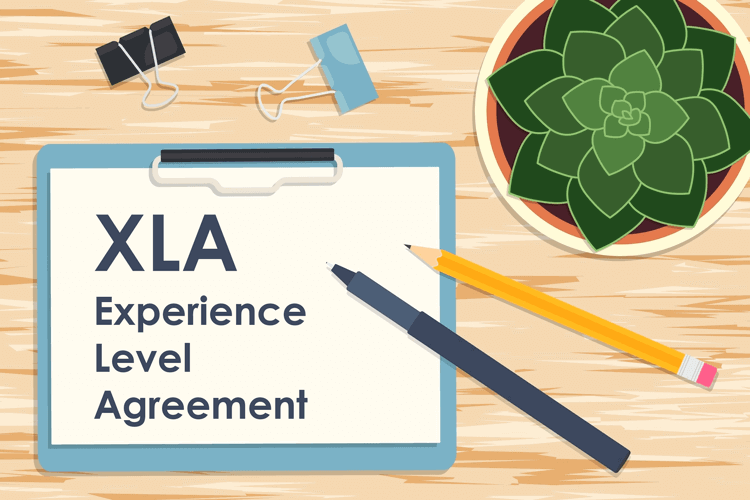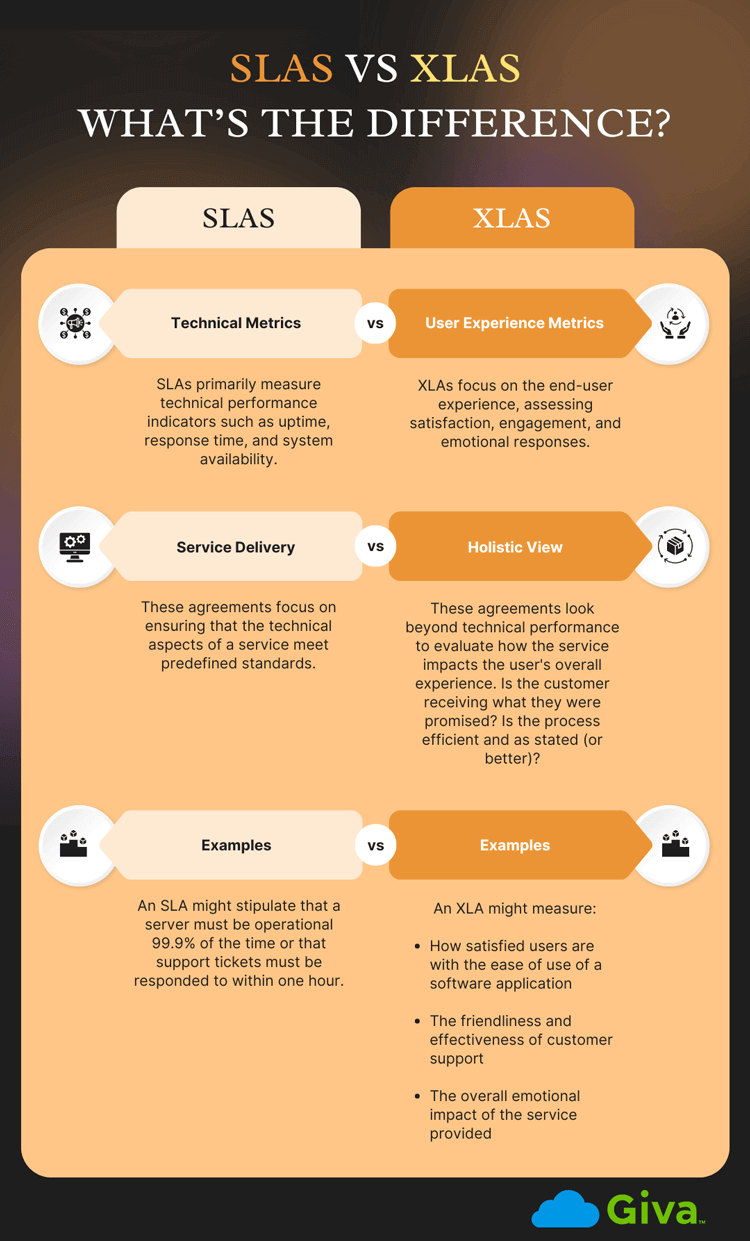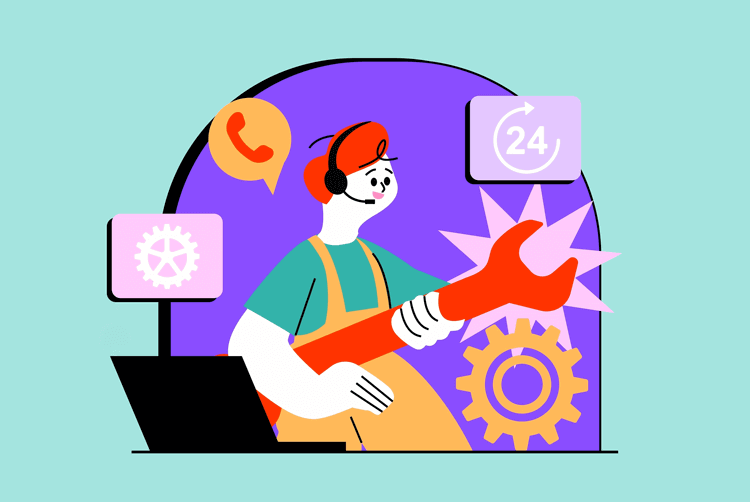Comprehensive Guide to XLAs: Experience Level Agreements and Their Importance
In today's customer-centric world, businesses must prioritize delivering outstanding service experiences. Experience Level Agreements (XLAs) are a necessity for achieving this goal, as they help organizations move beyond traditional Service Level Agreements (SLAs) to meet user expectations.
This blog post will explore what XLAs are and how they differ from SLAs and offer a comprehensive guide on designing and implementing them effectively.

What is an XLA?
An Experience Level Agreement (XLA) is a contract that focuses on the quality of the user experience with a service, rather than just technical performance metrics. XLAs aim to measure and improve overall satisfaction and the emotional response of users to the services they receive.
Unlike SLAs, which focus on technical performance metrics like uptime and response times, XLAs prioritize the end-user experience by measuring satisfaction, engagement, and overall emotional response to the service provided.
For example, an XLA for an IT helpdesk might track how users rate their overall support experience. These could include aspects such as:
- The friendliness of the support staff
- The clarity of communication
- The effectiveness of the solutions provided, rather than simply measuring how quickly issues are resolved
A Few Key Components
User Experience Metrics: These metrics go beyond traditional performance indicators to assess how users feel about the service. Would they rate you 5/5 stars? Do they intend to use your services again (or maybe they are already repeat customers).
Service Delivery Effectiveness: Measures how well the service meets user needs and expectations. If you promise your customers that your service produces fishing license renewals in under 10 minutes, does it work as intended? Can most users finish it in under 10 minutes?
Emotional Engagement: Evaluates the emotional responses and engagement levels of users interacting with the service. Does your service make a customer feel accomplished? Happy? Perhaps mad? You need to know.
XLAs vs. SLAs
While Service Level Agreements (SLAs) and Experience Level Agreements (XLAs) both aim to supply an end user with quality service delivery, they focus on different aspects of the service.
SLAs
- Technical Metrics: SLAs primarily measure technical performance indicators such as uptime, response time, and system availability.
- Service Delivery: These agreements focus on ensuring that the technical aspects of a service meet predefined standards.
- Examples: An SLA might stipulate that a server must be operational 99.9% of the time or that support tickets must be responded to within one hour.
XLAs
- User Experience Metrics: XLAs focus on the end-user experience, assessing satisfaction, engagement, and emotional responses.
- Holistic View: These agreements look beyond technical performance to evaluate how the service impacts the user's overall experience. Is the customer receiving what they were promised? Is the process efficient and as stated (or better)?
- Examples: An XLA might measure:
- How satisfied users are with the ease of use of a software application
- The friendliness and effectiveness of customer support
- The overall emotional impact of the service provided
Read more: 8 Key Metrics for Measuring Service Level Agreement Performance

How to Design and Implement XLAs
Important First Steps
-
Identify Critical User Experience Metrics
Start by determining which XLA metrics are most important to your users. These could include ease of use, response times, and/or emotional responses.
-
Engage Stakeholders
Collaborate with key stakeholders within your organization to understand their expectations and requirements for user experience. This will help ensure that the XLA aligns with both user needs and business goals. If the plan is to build a website with better accessibility features, improving ease of use, you will want to fit this within the corporate budget.
-
Set Realistic and Measurable Goals
Establish goals that are attainable and can be measured accurately. These goals should reflect the desired user experience outcomes and be based on the identified metrics. For instance, improving consumer support resolution by 15-seconds per call could be a start. If you meet the target, you could aim for even more next year.
-
Develop a Monitoring Plan
Create a plan for continuously monitoring the user experience. This should include regular data collection, analysis of said data, and reporting to track performance against the XLA. While your digital tools can provide important metrics, be sure to also send out customer surveys for added feedback.
Implementation Strategies
-
Integration with Existing Frameworks
Integrate XLAs with your existing IT Service Management (ITSM) frameworks to ensure a seamless approach. This might involve aligning XLAs with ITIL practices or incorporating them into your service desk operations.
-
Ability to "Change on the Fly"
While you regularly monitor user experience, be sure that you can make adjustments with speed and ease. For example, if you find customers are tapping around your website, but rarely checking out, it may be an indication that locating products is difficult. In this case, be sure that changes in the content management system are easy to make and quick to publish.
-
Training and Awareness
Educate your team about the importance of XLAs and how they differ from SLAs. Ensure that everyone involved in service delivery understands their role in achieving the desired user experience outcomes. Be sure to solicit your team's opinions for future improvement.
Challenges to Overcome
-
Data Collection and Analysis
Gathering and interpreting user experience data is critical but can be challenging. Ensure you have the right tools and processes in place to collect accurate and meaningful data. While there may be plenty of data points, the issue may boil down to the volume of data. This then can be a challenge to decipher when working in a smaller organization.
-
Aligning Organizational Culture
Shifting the focus from technical performance to user experience may require significant cultural changes within the organization. Technical employees may find it difficult to simultaneously play the lines of user experience and vice versa. If budget allows, it may be a wise decision to bring on an employee focused on user experience.
-
Setting Realistic Expectations
Managing stakeholder expectations can be difficult, especially if they are accustomed to traditional SLAs. Clearly communicate the benefits of XLAs and set realistic expectations for what can be achieved. Setting aggressive targets, and subsequently failing, can be the end of the road for XLA initiatives in the eyes of C-suite executives.
XLAs and AI: A Future Perspective
Current Tie-ins
AI technology is increasingly being utilized to enhance Experience Level Agreements (XLAs) by providing advanced analytics and insights into user experiences.
-
AI-Driven Analytics
AI tools can analyze large volumes of user feedback and behavior data to identify patterns and trends. These insights can help organizations understand how users interact with their services and pinpoint areas for improvement.
-
Large volume? No problem
In an example by McKinsey & Company, a "leading airline built a machine-learning system based on 1,500 customer, operations, and financial variables to measure both satisfaction and predicted revenue for its more than 100 million customers every day. The system allowed the airline to identify and prioritize those customers whose relationships were most at risk due to a delay or cancellation and offer them personalized compensation". This approach "resulted in an 800 percent uplift in customer satisfaction and a 60 percent reduction in churn for high-priority customers".
-
Sentiment Analysis
AI can perform sentiment analysis on customer feedback, social media mentions, and support tickets to gauge user emotions and satisfaction levels. This allows organizations to measure the emotional impact of their services in real-time.
-
Increasing Channel Support
AI-driven chatbots are one way in which AI is providing customers with "around the clock" service.
Future Possibilities
The future of XLAs is likely to see even deeper integration with AI, enabling more sophisticated and proactive approaches to managing user experiences.
-
Predictive Analytics
AI could be used to predict potential user experience issues before they arise. By analyzing historical data and user behavior, this technology can forecast problems and allow organizations to address them proactively. This can help reduce negative impacts on the user experience.
-
Is AI right for you?
A report by McKinsey & Company notes that companies that reach the highest level of AI maturity can "handle more than 95% of their service interactions via AI and digital channels", significantly enhancing efficiency.
-
Automated Issue Resolution
AI-driven solutions could automatically resolve common user experience problems. While AI-driven chatbots are already being used for this purpose, their prominence is expected to grow over time. Eventually, these AI-driven solutions might become as commonplace as having a customer service phone number or email address.
-
Personalized Experiences
AI can help create highly personalized user experiences by tailoring services and support based on individual user preferences and behavior.
The Bottom Line: Enhancing Your Customer Experience Plan with XLAs
While Service Level Agreements are critical for ensuring the technical performance of the software you purchase and run, incorporating Experience Level Agreements can significantly elevate your customers' overall perception and satisfaction. Customers are ultimately seeking a particular service or product, but providing them with an unforgettable, yet simple, experience along the way can keep them coming back again and again.
When it comes to the debate of XLA vs. SLA, understanding the differences enables organizations to tailor their service delivery more effectively to meet customer expectations. For businesses that already have both agreements in place, it might be time to take things to the next level. Consider leveraging AI technologies to further optimize XLAs through automated processes like 24-hour service, superior data management, and more predictable consumer behavior.
Experience Giva's Customer Service Software in the Cloud
Giva can help your customer service organization or call center bring best-in-class service to your customers.
Giva features include:
- AI Copilot Capability: Harness the power of Giva's AI Copilot to effortlessly refine responses and quickly access and format solution information, empowering agents to address customer issues with accuracy and efficiency.
- Customer Self-Service Portal: Provide customers around-the-clock access to customer service resources, so they can resolve their own issues before contacting your agents.
- Knowledge Base: Stop reinventing the wheel with a searchable knowledge base. Leverage valuable customer service resolutions previously created to resolve similar tickets.
- Automate and Schedule Tasks and Ticket Workflows: Automatically open tickets on a scheduled and recurring basis. Automate escalation and closure of tickets.
Let Giva partner with your support teams to work together for service success! Schedule a demo today, or start a free, 30-day trial!





